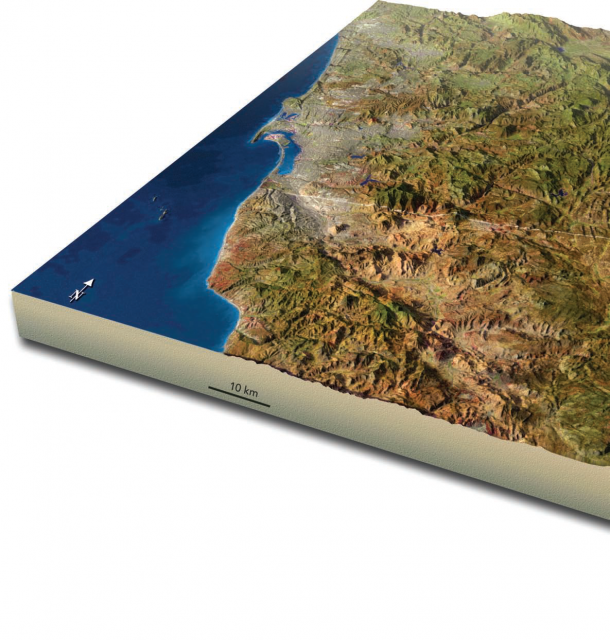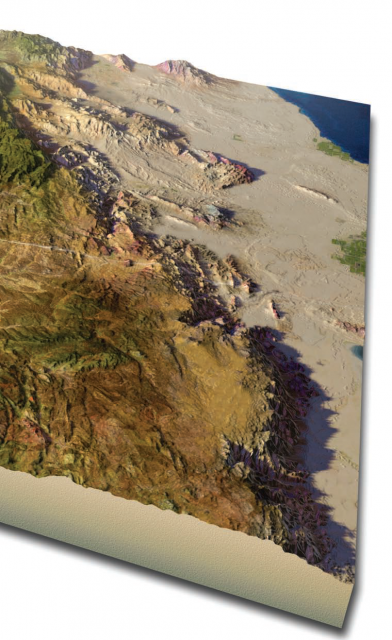Understanding Landscapes
THE FOUNDATIONS OF LANDSCAPES INCLUDE VARIOUS MATERIALS, including black lava flows, white sandy beaches, red cliffs, and gray granite hills. What causes these differences from one natural landscape to another, and how did the different kinds of materials form? Here, we explore landscapes and the materials that compose them. We also examine the processes that form different types of earth materials and learn how we can recognize what type of materials are present simply from the appearance of a landscape. Geographers consider landscapes to include the natural foundation of landscapes — the rocks, soils, and other earth materials — and anything on top of that foundation, such as vegetation and buildings. In this chapter we focus on the natural foundation, which provides the background to geomorphology, the study of landforms.

This perspective view shows satellite data superimposed over topography for southernmost California and adjacent Baja California, Mexico. The Peninsular Ranges, a forested mountainous area east of San Diego, are in greens and browns in the center of the image. The white line across the image, added for reference, marks the border between the United States and Mexico. Large parts of the mountains resemble a mound of granite boulders, as in the photograph below.
How does a landscape with this appearance form?
The Peninsular Ranges contain many exposures of grayish-colored rocks, most of which are rocks similar to granite. When viewed up close, the granite displays four different kinds of crystals: whitish, light pink, transparent gray, and black.
What are rocks made of, and what controls the color and other properties of a rock?

San Diego County is a famous source of beautiful minerals, including tourmaline crystals, that can be pink, purple, green, or all three colors.
What are crystals, how do they form, and where do we find them?

East of the Peninsular Ranges, the land drops down into the lowlands of the Salton Trough, which is characterized by sandy deserts, farmlands of the Imperial Valley, and several large, salty lakes, including the blue Salton Sea. The sand in the Salton Trough was eroded from the adjacent mountains and carried to the area by streams or strong winds.
W hat are most sand grains composed of?

The Peninsular Ranges
The area called the Peninsular Ranges is a broad, upland region that stretches 1,500 km across southernmost California and southward into the Baja Peninsula of Mexico.
In this image, the mountains appear green because they are mostly covered by forests and other types of vegetation. The lowlands of the Salton Trough east (right) of the mountains receive much less rain and have a lighter color in this image because vegetation is sparse and sand and rocks cover the surface. The contrast between the Peninsular Ranges and the Salton Trough illustrates some important aspects to consider when observing and thinking about landscapes. First, landscapes develop from the materials that are available. The mountains contain granite because that is the type of rock that was there, long before the mountains arose. The mountains would have a different appearance if they instead consisted of a material much weaker than granite and, in this case, might not even be mountains today. In addition to the type of materials, the geometry of the rock units and other materials can also impart a distinct style to the landscape. An appropriate place to begin thinking about landscapes is, therefore, to examine the repertoire of earth materials.
Once the materials are at the surface, they are acted on by the atmosphere, moisture in the soil, and other components of the environment that tend to break down rocks into loose materials. The kind of climate greatly influences this loosening process. Once loosened, these materials can be stripped off the land surface and transported away by running water, wind, and ice, eventually being deposited someplace else. This sequence of events is what shaped the mountains of the Peninsular Ranges and also deposited the resulting
loose materials in the Salton Trough. These processes are still occurring, so the landscape continues to evolve.